The geyser gas-fired Victorian water heater
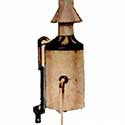
The geyser gas water heater was a narrow container which produced hot water rapidly from the cold mains supply by burning gas; this page explains how it worked and illustrates its use with photos, recollections and adverts. Its disadvantages as well as its advantages are recognised.
____
By the webmaster, based on contributions from others and additional research
Advantage of a geyser over a copper for heating water
The main problem with the more widespread copper water heaters was that their fires had to be laid in advance, stoked up and then cleared away after use. How much better if hot water could be available on tap.
An appliance known as a geyser did, in fact, produce hot water cleanly and with little or no effort. It was a narrow container which was normally wall mounted with its spout for the hot water directly over a basin, sink or bath. It used gas to heat cold water directly from the mains. The gas was coal gas.
Disadvantages of geyers over coppers
Unlike coppers which could provide enough hot water to cope with the weekly laundry, geysers could only supply relatively small amounts of water at a time.
There was another disadvantage as described below by people who experienced it.
Instant hot water - or not?
contributed by Bill Hogg, from personal experience
Geysers were advertised as providing instant hot water, but this was not quite true. They probably took just under half a minute to warm up from cold. The temperature could be set hotter or colder by adjusting the flow of gas, but that of course affected the user's waiting time.
contributed by Douglas Adam
The hot water supply from our geyser was endlessly slow.
Where were geysers installed?
Unlike coppers, geysers were normally installed in bathrooms - which only up-market houses had in Victorian and Edwardian times - and the bathrooms had to have a gas supply. They were also installed in the sculleries of better-off houses, over sinks for washing up.
The top image shows a geyser in a bathroom providing hot water for a bath. In practice this would be have been unlikely because, by the time that the geyser had produced enough water, the water produced earlier would have got cold.
In bathrooms, geysers would have been ideal for washing hands and faces.
Description and function of parts
The photo shows an early Victorian geyser which gave good service well into the 20th Century. It is made of copper and is about 2'6" feet high and 10" across.
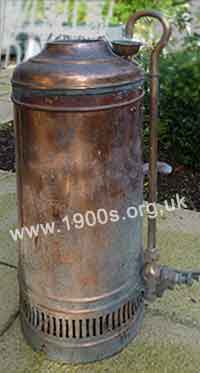
Victorian geyser for heating water.
Although shown
standing on a surface in the photo, it was wall mounted in use, as seems to have been the
case with most geysers. It was made of copper.
To get hot water, cold water was fed in via the tall external pipe shown in the photo. (Enlargements of the connections are below.) The pressure of the mains water forced the water upwards and out of the kink at the top into the little bowl and onwards into the geyser. The little bowl prevented splashing down the side.
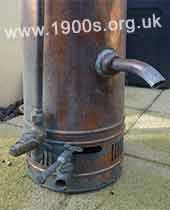
Lower section showing the spout for the emerging hot water and the entry connection for the cold water
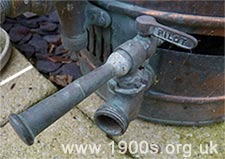
Detail of the gas pipes' entry point. The control for the pilot light is clearly marked 'PILOT'. The entry connection for the cold water is just visible on the far left.
The ring of gas burners
Inside the geyser, the water was heated by gas jets in a container at its base.
As the geyser was wall-mounted, you could look up inside it when it was lit and see all the flames from the ring of individual gas burners.
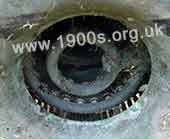
Underside showing the round gas pipe and base of the gas jets.
The hot water was delivered through the spout at the side of the geyser, shown in the second of the above photos. The temperature of the hot water could be managed by adjusting the supply of gas to the flames and the rate at which the water flowed. The spout is some way up from the base to allow some sort of receptical underneath. The geyser was normally either placed on a stand or attached to a wall so that the spout could be over a bath or basin, so allowing the hot water to run directly into the bath or basin.
The top of the geyser was open as an exhaust for the hot air from the gas burners.
The typical noise of a geyser lighting up
Everyone who has ever been with a working geyser remembers the noise that it made when starting up.
contributed by Stefany Reich-Silber, recollections
Our geyser made a great whoosh sound as the gas jets lit from the pilot light. Of course we had to have the requisite amount of shillings for the gas meter.
This recollection comes from our flat in a street full of large late Victorian villas.
Later geysers
Later geysers improved considerably in both design and efficiency.
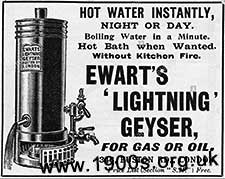
Advert for a still relatively early geyser. The cut-away sketch particulary clearly shows the positing of the gas burners, the vents around them for air intake and the connection for the water input, but not shown is its tall delivery pipe.
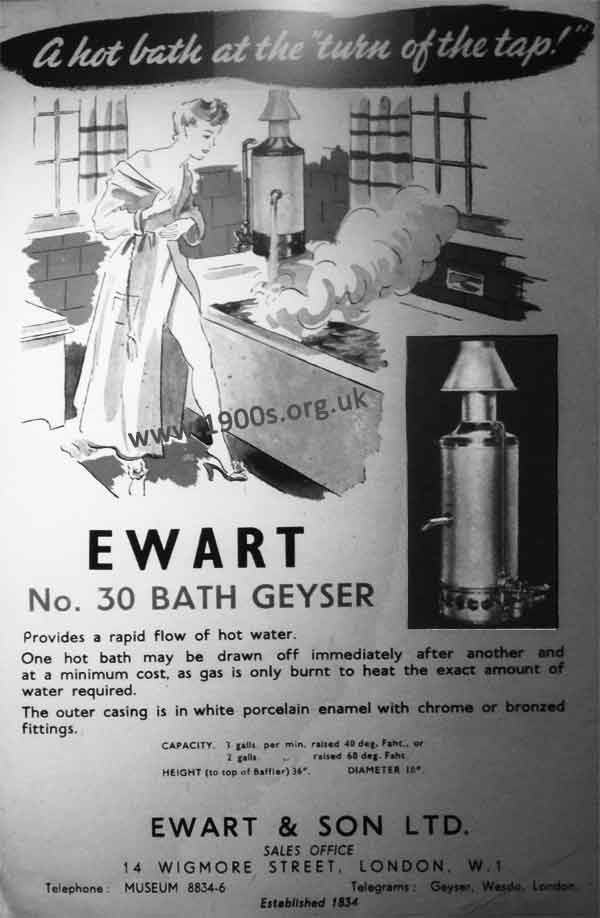
Advert for a 1950s geyser with a realistic drawing showing it heating a bath.
Adverts from old newspapers in the family of Lewis Elton
Smaller and more modern versions were usually enamel finished.
contributed by Bill Hogg, from personal experience
The geysers which I knew were all slightly different in detail. Some, for example, had a swivel outlet for the water.
The one in my 1950s sports club house was probably already old when I knew it. It was smaller than the one that Stefany Reich-Silber describes, perhaps only about two feet high and was over a wash basin - but it was certainly called a geyser, not the more modern Ascot.
| sources | webmaster | contact |
Text and images are copyright
If you can add anything to this page or provide a photo, please contact me.



